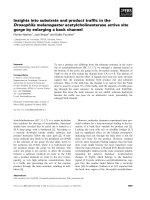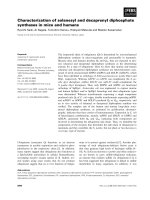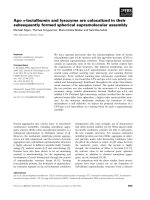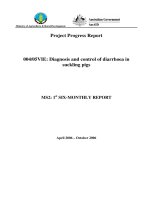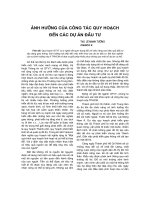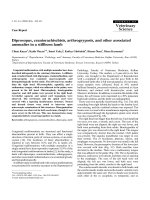Báo cáo khoa học: "Synchronous colorectal adenocarcinoma and gastrointestinal stromal tumor in Meckel''''s diverticulum; an unusual association" pps
Bạn đang xem bản rút gọn của tài liệu. Xem và tải ngay bản đầy đủ của tài liệu tại đây (801.37 KB, 5 trang )
BioMed Central
Page 1 of 5
(page number not for citation purposes)
World Journal of Surgical Oncology
Open Access
Case report
Synchronous colorectal adenocarcinoma and gastrointestinal
stromal tumor in Meckel's diverticulum; an unusual association
Christopher Kosmidis*
1
, Christopher Efthimiadis
1
, Sofia Levva
1
,
George Anthimidis
1
, Sofia Baka
2
, Marios Grigoriou
1
, Ioanna Tzeveleki
3
,
Maria Masmanidou
4
, Thomas Zaramboukas
5
and Georgios Basdanis
3
Address:
1
Department of Surgery, Interbalkan European Medical Center, Thessaloniki, Greece,
2
Department of Oncology, Interbalkan European
Medical Center, Thessaloniki, Greece,
3
1st Propedeutic Surgical Clinic, Aristotle University of Thessaloniki, AHEPA Hospital, Thessaloniki, Greece,
4
1st Propedeutic Clinic of Internal Medicine, Aristotle University of Thessaloniki, AHEPA Hospital, Thessaloniki, Greece and
5
Pathology
Department, Aristotle University of Thessaloniki, Thessaloniki, Greece
Email: Christopher Kosmidis* - ; Christopher Efthimiadis - ;
Sofia Levva - ; George Anthimidis - ; Sofia Baka - ;
Marios Grigoriou - ; Ioanna Tzeveleki - ; Maria Masmanidou - ;
Thomas Zaramboukas - ; Georgios Basdanis -
* Corresponding author
Abstract
Background: Coexistence of gastrointestinal stromal tumor with synchronous or metachronous
colorectal cancer represents a phenomenon with increasing number of relative reports in the last
5 years. Synchronous occurence of GISTs with other gastrointestinal tumors of different
histogenesis presents a special interest. We herein report a case of GIST in Meckel's diverticulum
synchronous with colorectal adenocarcinoma.
Case presentation: A 69 year old man, presented with abdominal distension and anal bleeding
on defecation. Colonoscopy revealed colorectal cancer and a low anterior resection was
performed, during which a tumor in Meckel's diverticulum was discovered. Histologic examination
revealed GIST in Meckel's diverticulum and a rectosigmoid adenocarcinoma.
Conclusion: Whenever GIST is encountered, the surgeon should be alert to recognize a possible
coexistent tumor with different histological origin. Correct diagnosis of synchronous tumors of
different origin is the cornerstone of treatment.
Background
Meckel's diverticulum is surgically removed only when a
complication arises or a neoplasia develops. Neoplastic
transformation has been reported, but gastrointestinal
stromal tumors (GISTs) are exceptional in this location
[1,2]. The management of GISTs has dramatically evolved
over the last ten years. However, their coexistence with
other gastrointestinal tumors of different histogenesis
presents a special clinical problem. We herein report a
case of GIST in Meckel's diverticulum synchronous with
colorectal adenocarcinoma.
Case presentation
A 69 year-old-man presented with abdominal distension
and anal bleeding on defecation. For the last six months
the patient was complaining of flatulence, periumbilical
Published: 23 March 2009
World Journal of Surgical Oncology 2009, 7:33 doi:10.1186/1477-7819-7-33
Received: 1 January 2009
Accepted: 23 March 2009
This article is available from: />© 2009 Kosmidis et al; licensee BioMed Central Ltd.
This is an Open Access article distributed under the terms of the Creative Commons Attribution License ( />),
which permits unrestricted use, distribution, and reproduction in any medium, provided the original work is properly cited.
World Journal of Surgical Oncology 2009, 7:33 />Page 2 of 5
(page number not for citation purposes)
pain and sensation of incomplete evacuation. Apart from
tenderness on deep palpation, blood on PR examination
and increased bowel sounds, all other systems were found
normal on clinical examination.
Colonoscopy revealed intraluminal stenosis of the color-
ectal junction and biopsy specimens were obtained.
Biopsy confirmed a well differentiated mucinous adeno-
carcinoma of the rectosigmoid colon. There was no evi-
dence of metastasis, based on abdominal computed
tomography (CT), chest X-ray and endorectal ultrasound
(US) 3D. Carcinoembryonic antigen (CEA), carbohydrate
antigen (CA) 19-9, and cancer antigen (CA) 50 were nor-
mal. Low anterior resection for colorectal carcinoma
(CRC) with an end to end primary anastomosis was per-
formed, while on exploration a mass in Meckel's divertic-
ulum, 80 cm proximal to the ileocecal valve, was
encountered (Figure 1). The mass was 7.5 cm in maximal
diameter (Figure 2A, B), while the size of the Meckel's
diverticulum was 3 cm. Thus, this case is classified as an
"intermediate risk" GIST according to the risk assessment
of aggressive behavior in GISTs proposed by Fletcher et al.
(size: 7.5 cm, mitotic count: 0-1/50 HPF) [3]. No evidence
of liver metastasis or intra-abdominal metastatic spread
was found. The patient underwent resection of the tumor
together with partial resection of the small bowel in order
to avoid rupture and intra-abdominal spillage. Tumor was
excised, together with 3 cm of ileum on either side, and a
lateral to lateral anastomosis was performed with the use
of staplers.
The lesion in the colorectal junction was a stage C2
(Astler-Coller) tumour, 8 × 6 cm in size (Figure 3), located
in the rectosigmoid colon. Microscopic examination
showed a well-differentiated adenocarcinoma, penetrat-
ing the bowel wall, without nerve and vascular invasion.
However, one of the 23 resected lymph nodes was positive
for metastasis. According to the TNM (tumor, lymph
nodes, metastasis) classification, the disease was stage
IIIb. Histopathological examination of the resected
Meckel's diverticulum tumor revealed a stromal cell neo-
plasm with a few necrotic and hemorrhagic areas and a
low index of mitotic count (0–1 mitoses/50 HPF) (Figure
4A, B). Immunohistochemical analysis revealed expres-
sion of C-kit (strongly positive), moderately positive stain
for SMA, while markers for focal S-100 and CD 34 were
negative (Figure 5).
Patient's postoperative course was uneventful, and he was
commenced on adjuvant chemotherapy with FOLFOX
regimen (oxaliplatin i.v., 85 mg/m2(on day 1), leuko-
vorin i.v., 200 mg/m2 (on days 1,2), 5 FU (fluorouracil)
i.v., bolus 400 mg/m2 (on days 1,2), 5 FU i.v., 22 hours-
infusion, 600 mg/m2 (on days 1,2), every 2 weeks for 12
cycles.
One year later he has no signs of local recurrence or metas-
tasis.
Discussion
The term GIST was introduced by Mazur and Clark in
1983 in order to define a heterogeneous group of neo-
plasms of spindle and epithelioid cells arising from the
stroma with no definite cell line of origin and varying pat-
terns of differentiation [4,5]. GISTs are considered to be
mesenchymal neoplasms, encompassing a majority of
tumors previously considered gastrointestinal smooth
muscle tumors, which, with the implementation of
immunohistochemical stains and electron microscopy in
recent years, have been recognized as a distinct patholog-
ical entity [3]. Their nomenclature, histogenesis, criteria
for diagnosis, prognostic manifestations, and classifica-
tion have raised much debate and controversy [6,7].
Though the most common mesenchymal tumors in the
gastrointestinal tract wall, arising from Cajal's cells, they
are rare neoplasms accounting for less than 1% of all gas-
trointestinal tumors [3].
The most common sites are stomach (60%) and small
intestine (30%). The average presentation is in the sixth
decade [8]. Most GISTs (>90%) express CD117, the c-kit
proto-oncogene protein that is a transmembrane receptor
for the stem cell growth factor, and 70% to 80% express
CD34, the human progenitor cell antigen; less often, these
tumors stain positive for actin and desmin [9].
The three most important factors in determining malig-
nancy are mitotic rate, tumor size and site [8,10-12].
Mitotic counts higher than 2 per 50 high-power fields
imply an increased risk for local recurrence in small bowel
GIST [10]. It is generally accepted that the criteria for pre-
The colorectal adenocarcinoma having been excised and the coexisted GIST in Meckel's diverticulumFigure 1
The colorectal adenocarcinoma having been excised
and the coexisted GIST in Meckel's diverticulum.
World Journal of Surgical Oncology 2009, 7:33 />Page 3 of 5
(page number not for citation purposes)
dicting biological behavior may differ significantly with
location. For example gastric GISTs are less aggressive
than those located in small bowel. In the small intestine
there is an overall 39% tumor related mortality, twice that
for gastric GISTs [8,13].
Smaller GISTs are often incidental findings during sur-
gery, radiologic studies, or endoscopy. Coexisting stromal
tumors are usually very small and are detected inciden-
tally during gastrointestinal surgery for carcinomas [14].
In our case the patient presented with anal bleeding,
which was attributed to the colorectal carcinoma. Preop-
erative evaluation did not reveal the unique coexistence of
tumor in Meckel's diverticulum along with the rectosig-
moid cancer, even though the tumor was large, 7.5 cm in
maximal diameter.
The patient underwent an en-block resection of the tumor
to avoid rupture and intra-abdominal spillage, as it is rec-
ommended [10]. He was commenced on adjuvant chem-
otherapy with oxaliplatin, leukovorin, and fluorouracil.
Imatinib mesylate was not used since treatment of local-
ized GIST is complete surgical excision, without dissection
of lymph nodes [11,12] and adjuvant treatment with
imatinib is still under consideration. Imatinib is the
standard treatment if complete surgery is not feasible [11].
As the localized GIST was excised intact, there was no
rationale to submit the patient to a treatment that should
be continued indefinitely and the long-term success of
which is limited by development of imatinib resistance
via secondary mutations or clonal selection [11].
Despite the considerable development in the manage-
ment of GISTs the last 10 years and the immense progress
recently made in understanding the molecular biology of
GISTs, little is yet known about their rare synchronous
occurrence with tumors of different histogenesis. GISTs
have been reported to occur synchronously with colon
adenocarcinoma, gastric cancer, lymphoma and carcinoid
[13,15-18]. The coexistence of GIST with either synchro-
nous or metachronous colorectal cancer represents a rare
A: The specimen of the GIST in Meckel's diverticulumFigure 2
A: The specimen of the GIST in Meckel's diverticulum. The arrow shows the diverticulum. B: Transverse section of the
specimen of the GIST in Meckel's diverticulum and the proximal part of the ileum. The arrow shows the diverticulum.
The specimen of the colorectal adenocarcinomaFigure 3
The specimen of the colorectal adenocarcinoma.
A) Invasion of submucosa of small intestine from GIST (HE×200)Figure 4
A) Invasion of submucosa of small intestine from
GIST (HE×200). B) Histologically, the GIST was composed
of sheets of spindle cell with moderate to slight interstitial
collagen (HE×200).
World Journal of Surgical Oncology 2009, 7:33 />Page 4 of 5
(page number not for citation purposes)
phenomenon with increasing number of relative reports
in the last 5 years.
Although the synchronous occurrence of GIST and other
abdominal malignancy seems to be just a coincidence,
combined genetic deregulation or influenced neighboring
tissues by the same carcinogen could be causative factors
[17,19]. There are some data regarding the co-occurrence,
the association and the potential common origin (genetic
pathways of tumorigenesis), between GIST and other
tumors [18-20]. The limited number of these cases cannot
confirm the existence of a common factor in tumorigene-
sis of these histopathologically completely different
tumors and further studies are needed to clarify the possi-
ble association.
Most of the published cases describe gastric stromal
tumors synchronous with another gastric malignancy.
Our case describes a concomitant GIST in Meckel's diver-
ticulum with a colorectal adenocarcinoma. As far as we
could elicit from the literature, this is the first report of
such tumor coexistence with regard to location.
Conclusion
The role of thorough abdominal exploration despite
advanced preoperative imaging techniques cannot be
overemphasized. In case of colorectal cancer, the doctor
should bear in mind the possibility of coexistent tumor
with different histological origin elsewhere in the GI tract.
Consent
Written informed consent was obtained from the patient
for publication of this Case report and any accompanying
images. A copy of the written consent is available for
review by the Editor-in-Chief of this journal.
Competing interests
The authors declare that they have no competing interests.
Authors' contributions
KC and EC and BG performed the operation and together
with AG and GM contributed to the conception and
design of the manuscript. LS, BS, MM, and TI analyzed
and interpreted the patient data regarding the disease. AG
and LS were major contributors in writing the manuscript.
ZT carried out the histology and immunohistochemistry
examination. All authors read and approved the final
manuscript.
References
1. Haber JJ: Meckel's diverticulum. Am J Surg 1947, 73:468-485.
2. Chandramohan K, Agarwal M, Gurjar G, Gatti RC, Patel MH, Trivedi
P, Kothari KCL: Gastrointestinal stromal tumour in Meckel's
diverticulum. WJSO 2007, 5:50.
3. Fletcher CD, Berman J, Corless CL, Gorstein F, Lasota J, Longley B,
Miettinen M, O'Leary TJ, Remotti H, Rubin BP, Shmookler B, Sobin
LH, Weiss SW: Diagnosis of gastrointestinal stromal tumors:
a consensus approach. Hum Pathol 2002, 33:459-465.
4. Mazur MT, Clark HB: Gastric stromal tumors. Reappraisal of
histogenesis. Am J Surg Pathol 1983, 7:507-519.
5. Feldeman M, Scharschmidt BF, Sleisenger MH: Sleisenger &
Fordtran's Gastrointestinal and Liver Disease. 6th edition.
Philadelphia: W.B. Saunders; 1998.
6. Hasegawa T, Matsuno Y, Shimoda T, Hirohashi S: Gastrointestinal
stromal tumor: consistent CD117 immunostaining for diag-
nosis, and prognostic classification based on tumor size and
MIB-1 grade. Hum Pathol 2002, 33:669-676.
7. Yamada T: Textbook of Gastroenterology 4th edition. Philadelphia: Lip-
pincott Williams & Wilkins; 2003.
8. Miettinen M, Lasota J: Gastrointestinal stromal tumors: review
on morphology, molecular pathology, prognosis and differ-
ential diagnosis. Arch Pathol Lab Med 2006, 130:1466-1478.
9. De Matteo RP: The GIST of targeted cancer therapy: A tumor
(gastrointestinal stromal tumor), a mutated gene (c-kit),
and a molecular inhibitor (STI571). Ann Surg Oncol 2002,
9:831-839.
10. D'Amato G, Steinert DM, McAuliffe JC, Trent JC: Update on the
biology and therapy of gastrointestinal stromal tumors. Can-
cer Control 2005, 12:44-56.
11. Casali PG, Jost L, Reichardt P, Schlemmer M, Blay JY, ESMO Guide-
lines Working Group: Gastrointestinal stromal tumors: ESMO
clinical recommendations for diagnosis, treatment and fol-
low up. Annals of Onc 2008, 19(S2):ii35-38.
12. Weber AG, Jovenin N, Lubrano D, Journu J, Yaziji N, Bouche O, Die-
bold MD, Delattre JF: Outcome after surgical treatment of gas-
trointestinal stromal tumors. Gastroenterol Clin Biol 2007,
31:579-584.
13. Wronski M, Ziarkiewicz-Wroblewska B, Gornicka B, Cebulski W,
Slodkowski M, Wasiutynski A, Krasnodebski IW: Synchronous
occurrence of gastrointestinal stromal tumors and other pri-
mary gastrointestinal neoplasms. World J Gastroenterol 2006,
12:5360-5362.
14. Agaimy A, Wünsch PH, Sobin LH, Lasota J, Miettinen M: Occurrence
of other malignancies in patients with gastrointestinal stro-
mal tumors. Semin Diagn Pathol 2006, 23:120-129.
15. Kaffes A, Hughes L, Hollinshead J, Katelaris P: Synchronous pri-
mary adenocarcinoma, mucosa-associated lymphoid tissue
lymphoma and a stromal tumor in a Helicobacter pylori-
infected stomach. J Gastroenterol Hepatol 2002, 17:1033-1036.
16. Kover E, Faluhelyi Z, Bogner B, Kalmar K, Horvath G, Tornoczky T:
Dual tumors in the GI tract: synchronous and metachronous
Immunohistochemically, spindle cells showed cytoplasmic staining for CD117(c-kit) (×200)Figure 5
Immunohistochemically, spindle cells showed cyto-
plasmic staining for CD117(c-kit) (×200).
Publish with BioMed Central and every
scientist can read your work free of charge
"BioMed Central will be the most significant development for
disseminating the results of biomedical research in our lifetime."
Sir Paul Nurse, Cancer Research UK
Your research papers will be:
available free of charge to the entire biomedical community
peer reviewed and published immediately upon acceptance
cited in PubMed and archived on PubMed Central
yours — you keep the copyright
Submit your manuscript here:
/>BioMedcentral
World Journal of Surgical Oncology 2009, 7:33 />Page 5 of 5
(page number not for citation purposes)
stromal (GIST) and epithelial/neuroendocrine neoplasms.
Magy Onkol 2004, 48:315-321.
17. Maiorana A, Fante R, Cesinaro MA, Fano AR: Synchronous occur-
rence of epithelial and stromal tumors in the stomach: a
report of 6 cases. Arch Pathol Lab Med 2000, 124:682-686.
18. Usui M, Matsuda S, Suzuki H, Hirata K, Ogura Y, Shiraishi T: Soma-
tostatinoma of the papilla of Vater with multiple gastrointes-
tinal stromal tumors in a patient with von Recklinghausen's
disease. J Gastroenterol 2002, 37:947-953.
19. Andea AA, Lucas C, Cheng JD, Adsay NV: Synchronous occur-
rence of epithelial and stromal tumors in the stomach. Arch
Pathol Lab Med 2001, 125:318-319.
20. Sugimura T, Fujimura S, Baba T: Tumor production in the glan-
dular stomach and alimentary tract of the rat by N-methyl-
N'-nitro-N-nitrosoguanidine. Cancer Res 1970, 30:455-465.
21. Miettinen M, Makhlouf HR, Sobin LH, Lasota J: Gastrointestinal
stromal tumors (GISTs) of the jejunum and ileum: a clinico-
pathologic, immunohistochemical and molecular study of
906 cases prior to imatinib with long-term follow-up. Am J
Surg Pathol 2006, 30:477-489.

